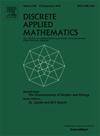Clique Cover on L-EPG representations of graphs
IF 1
3区 数学
Q3 MATHEMATICS, APPLIED
引用次数: 0
Abstract
Clique Cover is a classical graph theory problem where we are given a graph , an integer , and asked if can be partitioned into at most cliques. Edge intersection graphs of paths in grids (EPG graphs) are graphs whose vertices can be represented as nontrivial paths in a grid such that two vertices are adjacent if and only if the corresponding paths share at least one edge of the grid. When the paths have at most one change of direction (bend), these graphs are called -EPG graphs; in addition, they are called -EPG graphs (or -shaped graphs) if all the paths are represented with one of the following shapes: “”, “–”, or “”. Such a representation is called -EPG representation. The class of -EPG graphs is a natural superclass of interval graphs. Since all maximal cliques of a -EPG graph can be computed in polynomial time, and Clique Cover on interval graphs is polynomial-time solvable; in this paper, we study the complexity of Clique Cover on -EPG graphs. We show that given an -EPG representation of a graph , it is NP-complete to determine whether can be partitioned into at most cliques, but it can be solved in FPT time when parameterized by . Furthermore, we adapt our algorithm to the case where the input is a graph without its -EPG representation. Finally, we also show that Clique Cover on EPG representations (a particular class of -EPG representations) is polynomial-time solvable.
求助全文
约1分钟内获得全文
求助全文
来源期刊

Discrete Applied Mathematics
数学-应用数学
CiteScore
2.30
自引率
9.10%
发文量
422
审稿时长
4.5 months
期刊介绍:
The aim of Discrete Applied Mathematics is to bring together research papers in different areas of algorithmic and applicable discrete mathematics as well as applications of combinatorial mathematics to informatics and various areas of science and technology. Contributions presented to the journal can be research papers, short notes, surveys, and possibly research problems. The "Communications" section will be devoted to the fastest possible publication of recent research results that are checked and recommended for publication by a member of the Editorial Board. The journal will also publish a limited number of book announcements as well as proceedings of conferences. These proceedings will be fully refereed and adhere to the normal standards of the journal.
Potential authors are advised to view the journal and the open calls-for-papers of special issues before submitting their manuscripts. Only high-quality, original work that is within the scope of the journal or the targeted special issue will be considered.
 求助内容:
求助内容: 应助结果提醒方式:
应助结果提醒方式:


